The city of Pamplona in northern Spain is the capital of the autonomous region of Navarra. It is a historic destination best known for its bullrunning festival which takes place every July. It is also the first Spanish city on the French Way of the Camino de Santiago pilgrim’s route which runs from St Jean Pied de Port in France via Roncesvalles in the Pyrenees to Santiago de Compostela in Galicia. The city became famous for many people thanks to the writings of Ernest Hemingway whose 1926 novel ‘The Sun Also Rises’ described his time at the the San Fermin fiestas.
A Short History of Pamplona
Well before the arrival of the Romans the area of modern day Spain which which we know as Navarra was occupied by a tribe called the Vascones. Their settlement was called Iruña which simply means ‘City’ in the Basque language. Anyone who’s driven around this area will testify that they have been confused by road signs for ‘Iruña’ which is the Basque name for the city which we know as Pamplona! The Roman city of Pompaelo was founded here in 75BC as a camp between modern day Bordeaux and Astorga.
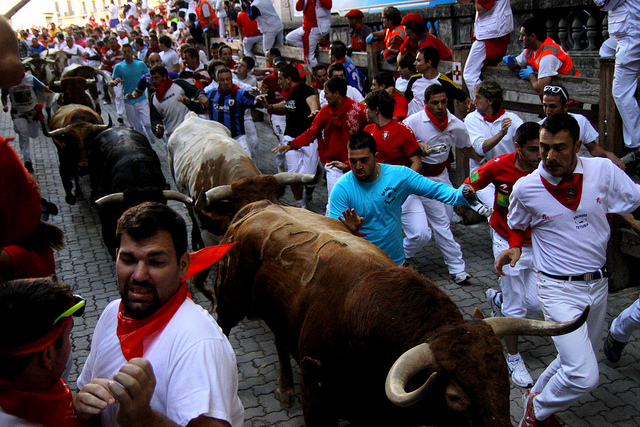
Throughout Roman, Visigothic and Moorish rule the Vascones maintained a certain independence. During the early years of the Reconquest the Kingdom of Pamplona was founded (824) later becoming the Kingdom of Navarre (1162). This vast area at one time or another included parts of the modern-day regions of Aragón, the Basque country, Cantabria, Castilla y León and La Rioja.
In 1512 the southern part of the Kingdom of Navarre was annexed by the unified Kingdom of Spain whilst some northern areas remained independent until it joined the Kingdom of France in 1589. Pamplona remained the capital of this semi-autonomous Kingdom of Navarre which served as a distant outpost of Castilian Spain served with protecting the interests of the Spanish Crown against invasions from France. As such the city’s fortifications were strengthened, turning Pamplona into a well-defended fortress hidden behind formidable walls which can be seen to this day.
It wasn’t until the 20th Century that Pamplona developed into a modern city which enjoys a standard of living and quality of life considerably higher than the national average.
Getting to Pamplona
By Air: Pamplona does have its own airport which lies 6km from the city centre, however, there are no international flight arrivals so you’ll need to fly to Madrid first then take a domestic connection. Domestic flights on this route tend to be pricey. Alternatively you could fly to Bilbao or Barcelona then make overland arrangements.
By Train: If you’re in the UK you can take the Eurostar to Paris Gare du Nord, take the metro to Paris Montparnasse then get the train to Hendaye/Irun on the French/Spanish border. There are infrequent buses from Irun to Pamplona but after a long journey through France you’d be better off taking the Metro Donostialdea from Hendaye (operated by Euskotren Trena) to San Sebastian for the night then continuing on to Pamplona a day or two later. Look for Donastia on the timetable as this is the Basque name for San Sebastian. Get off at Amara station which is the main one of three in the city.
The journey from San Sebastian to Pamplona by train takes about 2 hours. There are also trains to Pamplona from Madrid Atocha (4½ hours) and Barcelona Sants (6 hours). There is no direct train from Bilbao. Check the RENFE website for up to date timetables.
Pamplona Train Station (Plaza de La Estación): The RENFE train station lies 2km north-west of Plaza del Castillo on Avenida de San Jorge Etorbidia. There are frequent buses to the centre of town.
By Bus: There are frequent bus services from Bilbao (1¾ hours), San Sebastian (1 hour), Barcelona (5 hours) and Madrid (5 hours). There’s no problem travelling by bus but personally I’d recommend trains in Spain when the option is available.
Pamplona Bus Station (Calle Yanguas y Miranda, 2): Located next to the La Ciudadela green area the main bus station is just 800m south-west of Plaza del Castillo. You can walk to the centre of the Old Town in 10 minutes. Its left-luggage lockers are on the 2nd floor.
By Ferry: Another option if you’re travelling from the UK is to take a ferry to Santander or Bilbao from Portsmouth or Plymouth from where you can get to Pamplona by public transport or by driving.
On Foot: Every year thousands of pilgrims walking the French Way of the Camino de Santiago arrive in Pamplona on their way to Santiago de Compostela. Typically Pamplona will be on the 4th day of this month-long hike for pilgrims who take the route through the Pyrenees via Roncesvalles.
Bilbao Airport Car Hire
If you fly into Spain, you can hire a car at Bilbao Airport then drive less than two hours to get to Pamplona. The vehicle then provides you with the option of taking a tour of Navarra, La Rioja and the Basque Country.
Where to Stay
Hotels in Pamplona
Hotel prices are inflated beyond belief during the fiestas and are often sold-out months in advance so make sure you plan well ahead if that’s your reason for going to Pamplona. Otherwise you’ll find a good range of both historic and modern properties scattered around the city. Here are a few of our favourites:
Gran Hotel La Perla (Plaza del Castillo 1): Overlooking Plaza Castillo this hotel is 5-star luxury in the heart of the historic centre. Great choice if you want to treat yourself on the Camino de Santiago.
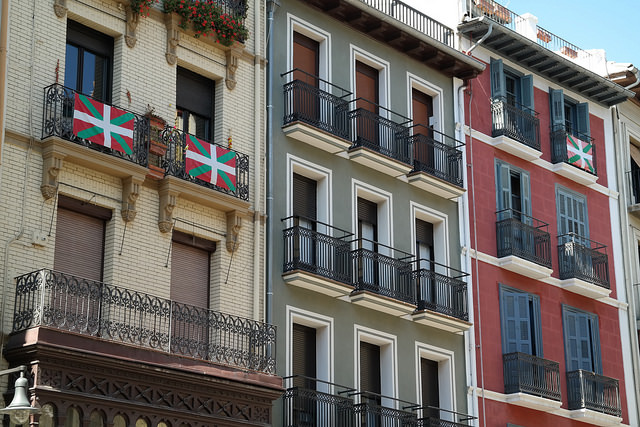
Hotel Palacio Guendulain (C/ Zapateria, 53): Personally I love historic places to stay so this really fits the bill as far as I’m concerned. It’s a luxurious 4-star option which is built in what was formerly a royal palace. Not the easiest place to find if you’re driving but well worth the effort.
Alma Hotel Pamplona – Muga de Beloso (C/ Beloso Bajo 11): If you are driving and prefer the convenience of being located on the outskirts of the city then this is the place for you. It’s a modern 4-star property with first class amenities throughout.
Budget Hostels in Pamplona
There’s an impressive range of accommodation in and around the Casco Antiguo including a number of budget options. below are listed a few recommendations but do bear in mind that advance bookings are essential if you plan on visiting during the fiestas:
Hostel Hemingway (C/ de Amaya, 26): This friendly hostel is located in the heart of Pamplona. It has a selection of small dormitories, a shared kitchen and public areas.
Aloha Hostel (C/ de Sangüesa, 2-1º): This centrally located property has a selection of dormitory rooms and a shared outdoor area which is popular with guests.
Apartments in Pamplona
If you’re interested in renting a self-catering apartment for your stay then take a look at the Airbnb.com website where individual owners rent out rooms or their full property. There are over 400 places currently on offer in Pamplona with prices rocketing during the San Fermín fiestas.
Camping Near Pamplona
Open all year round, the excellent Camping Ezcaba is just 7km from the city. The place is pretty hectic during the fiestas when pre-booking is essential but for much of the rest of the time it’s a relaxing place from which to discover the region.
Main Tourist Attractions
Whilst the city of Pamplona is synonymous worldwide with its bull-running festival there are plenty more reasons to pay it a visit. Here are some of the main sights:
Casco Viejo: The Old Town of Pamplona was once protected on all sides by the ancient city walls. Today it is the historic centre where you will spend most of your time as it is home to the majority of Pamplona’s main tourist attractions including the Cathedral (Catedral de Santa María la Real), Castle Square (Plaza del Castillo), the Town Hall (Casa Consistorial) and Calle Estafeta which is the main street which the bulls run along during the San Fermin fiestas. In addition the Old Town is packed with traditional bars and restaurants.
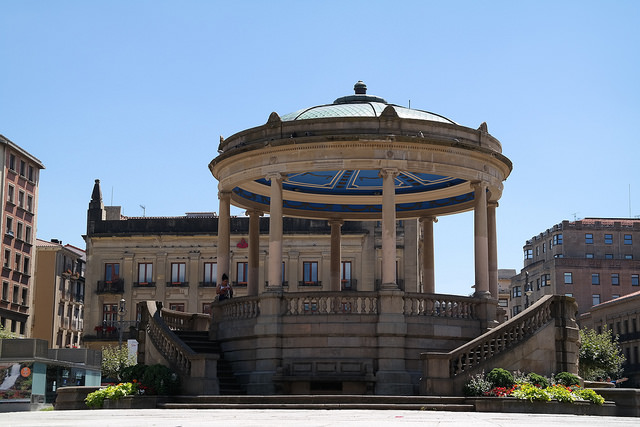
Pamplona Cathedral: The city’s most important religious building is its 14th century Gothic Cathedral which took 130 years to build. It is officially known as La Catedral de Santa María la Real de Pamplona. As well as serving as a functioning Cathedral it houses a vast collection of art and historical artefacts. It is also home to the mausoleum of King Charles III (Carlos III) who as King of Navarre married Eleanor of Castile in 1375 to end conflict with Castile. He is also important in the city’s history for unifying its boroughs in 1423 after centuries of strife between them. The crypt beneath the Cathedral holds the remains of all the Kings of Navarre since 1134 but isn’t open to visitors.
The Cathedral’s Museum of Religious Art (Museo Catedralicio Diocesano de Pamplona) at the entrance to the Cathedral is one of the city’s most important museums and is well worth a visit.
Plaza del Castillo: Over the centuries this historic square has served as the city’s civic centre, hosting all kinds of celebrations, markets and even bullfights. Today it continues this role as the beating heart of Pamplona’s Old Town surrounded by lively terrace bars and restaurants frequented by locals and visitors alike. Perhaps its most famous bar is Café Iruña (Plaza del Castillo, 44) which Hemingway refers to in his celebrated novel based in Pamplona, “The Sun Also Rises”. The writer is also known to have stayed in a hotel overlooking the square in what is today called the Gran Hotel La Perla (Plaza del Castillo, 1).
Casa Consistorial: At midday on 6th July every year a rocket is launched from the balcony of Pamplona’s Town Hall building which marks the beginning of the San Fermín festival. This is known as ‘El Chupinazo’. Down below in the Town hall Square (Plaza Consitorial) thousands of people dressed in white with a red scarf await the rocket which signifies that the party has begun. The building itself has served as the city’s main government building since 1423 when King Carlos III ordered its construction in the urban centre. It has been rebuilt twice since that time whilst holding on to some of its earlier baroque design.
Calle Estafeta: Images of the city’s most famous street are broadcast through the world’s media every July as bull-runners charge along it trying to avoid contact with the 600kg bulls which are in hot pursuit during the San Fermín fiestas. Outside fiesta time this 250 metre residential street is fairly innocuous. It’s hard to believe how it is transformed once the festival comes around.
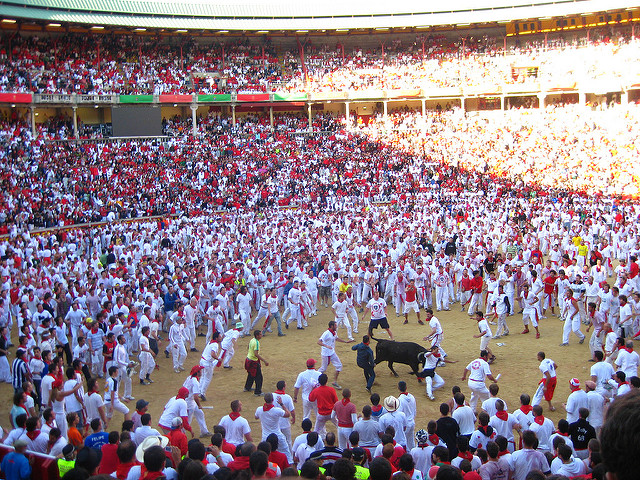
Pamplona City Walls: From the 16th to the 18th century Pamplona served as an important fortress town protected on three sides by its defensive walls and on the other by a citadel (La Ciudadela). Whilst much of the original wall has been destroyed as the city has expanded there are still some well preserved sections remaining. You can take a fascinating 5km walk along the walls looking down on the Old Town (Casco Antiguo) which they once protected. The best place to start is at the Information Centre (Centro de Interpretación de las Fortificaciones de Pamplona) on Calle Arrieta con Aralar where you can pick up a map and information about the history of the walls.
La Ciudadela: The citadel itself was built in 1571 under Philip II (Felipe II) who wanted to ensure thet Pamplona was a formidable fortress town. Today the citadel and its surrounds serve as the city’s most frequented green area known as Vuelta del Castillo Park. It’s located just south of the Old Town and is a popular place for tourists to take a break from their sightseeing. Cultural exhibitions frequently take place in what used to be military buildings.
Museo de Navarra (C/ Cuesta Santo Domingo): If you’re interested in learning a little about the history of this fascinating region of Spain then it’s well worth paying a visit to the Museum of Navarre. The museum is housed in what was formerly a hospital in the 16th century (Nuestra Señora de la Misericordia). It tells the story of Navarra through an impressive selection of archaeological and artistic exhibits dating from prehistoric times to the modern era with the Roman period particularly well represented.
Other Churches: Whilst the Cathedral is without a doubt the main religious building of interest, there are also a number of other interesting churches scattered around the Old Town including the 12th century San Nicolás (C/ de San Miguel, 15), 13th century San Saturnino (C/ San Saturnino, 3) and the 14th century San Lorenzo (C/ Mayor, 74). The latter is best known for its Capilla de San Fermín, a small chapel where a statue of Navarra’s patron saint resides all year round except for 7th July when it is part of the annual procession through the streets of the Old Town.
Parque de La Taconera: Located near the city’s Casco Viejo this extensive green area has been part of city life for centuries and is a great place to wander once you need a break from all the historic attractions. There are a number of relaxing walking routes around the park and a mini-zoo that’s worth a visit.

Plaza de Toros de Pamplona: At the end of each bull-run during the San Fermín fiestas the bulls arrive in the city’s bullfighting arena where they will fight that same evening. Standing on the appropriately named Paseo de Hemingway, the bullring was built in 1922. It has a capacity of 19,721 making it the world’s 3rd largest after Mexico City and Madrid.
Festivals in Pamplona
The city of Pamplona is synonymous with its annual bullrunning festival which is officially known as Las Fiestas de San Fermín or Sanfermines. The festival begins at noon on 6th July and lasts until midnight on 14th July. Bull-runs take place at 8am every morning from 7th to 14th attracting more than 20,000 runners over the eight mornings and an estimated million visitors to the city. For more information take a look at our San Fermín Fiestas page.
Whilst no other event comes even close to San Fermín in terms of attendance, there are still some other interesting local events during the year. The best place to check on such local festivities is on the Pamplona Town Hall Website.
Restaurants in Pamplona
Restaurante Europa (C/ Espoz y Mina, 11): Normally I’d run a mile at the suggestion of ‘nouvelle cuisine’ but in this place there’s nothing to fear. Considered one of the city’s finest restaurants, the Europa offers traditional dishes from Navarra with a classy twist which has earned the place a Michelin star. Great choice for a special occasion.
Restaurante San Fermin (C/ San Nicolas, 44-46): Lovely restaurant located on the first-floor of a building in the Casco Antiguo. They offer a selection of superbly prepared Navarran dishes which change according to the season ensuring the finest quality. Highly recommended is the tasting menu.
Restaurante Anttonenea (C/ de San Antón, 48): Superb venue for highly quality meat dishes accompanied with fine Navarran red wine. Whilst their T-bone steak (chuletón de buey) and lamb options are favourites they also offer some excellent fish dishes and a popular tasting menu.
Asador Zaldiko (Cuesta de Santo Domingo, 39): If you’re a meat lover the short stroll north-west of the historic centre to Zaldiko is well worthwhile. Enormous and superbly grilled steaks are the order of the day in this establishment with local ciders and Navarran wines adding to the rustic experience.
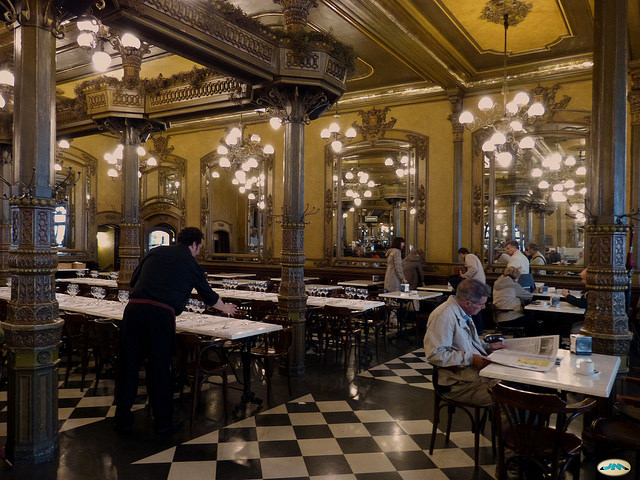
Café Iruña (Plaza del Castillo, 44): The dining room of this historic café is notable for its belle époque style which no doubt attracted Ernest Hemingway and friends during his time in Pamplona. The writer certainly put the café on the map thanks to references to it in his classic novel “The Sun Also Rises”. Sitting outside with their lunchtime ‘menú del día’ is highly recommended. Well worth a visit amongst the hordes of tourists who visit the café but not the best venue for a great meal.
Some of Pamplona’s Best Tapas Bars
Bars in Navarra and the Basque Country usually refer to ‘Pintxos’ rather than ‘Tapas’. To all intents and purposes the two are the same thing, the only difference being that ‘Pintxos’ usually have a toothpick through them and are often attached to a slice of bread. Here are a few recommended tapas (or pintxos) bars which are worth visiting during your time in Pamplona:
Bar Gaucho (C/ de Espoz y Mina, 7): Located just off Calle Estafeta, this has long been a popular spot amongst locals thanks to the exquisite tapas on offer. One of the best places in town to try superb ‘pintxos’.
Bar Restaurante Baserri (C/ San Nicolás, 32): This long-established haunt located amongst lots of other bars and restaurants along Calle San Nicolás is popular with locals and visitors alike. If it’s packed with standing room only you can try their restaurant at the back.

Bar Restaurante Iruñazarra (C/ Mercaderes, 15): This elegant establishment is the place to go for gourmet-tapas at the bar or head downstairs for first class a la carte dining in their restaurant.
La Cocina De Alex Mugica (C/ de la Estafeta, 24): One of the city’s most highly regarded establishments for creative tapas, all of which are made to order. Excellent presentation of a range of tasty dishes together with an excellent wine selection.
Bar La Botería (C/ Roncesvalles): Small place with a nice terrace located just across the road from the bullring. They serve a fine selection of ‘pintxos’ and have an impressive wine list.
Excursions From Pamplona
If you’re in Pamplona for long enough or visiting as part of a general touring holiday of the region, you’ll find there are some lovely excursions within easy reach of the city.
Parque Natural Urbasa Andia: Located 60km west of Pamplona following the A-12 via Puente La Reina this beautiful national park with waterfalls and turquoise lakes is a lovely place to go for a day hike on a nice day. A good place to park the car is at the small village of Banquedano where you can pick up a map in the information booth before beginning a walk in the Nacedero del Urederra section of the park.
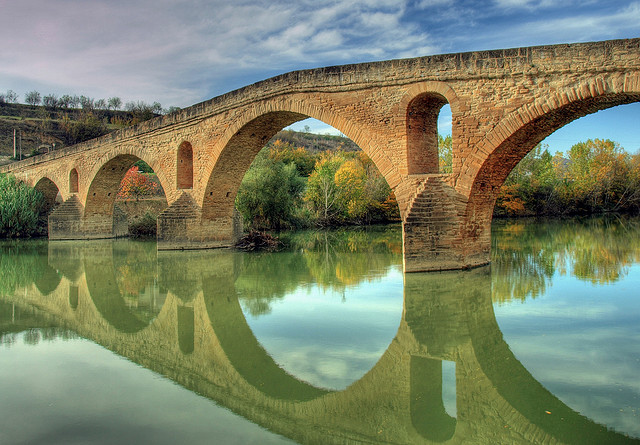
Puente La Reina: Just 20km south-west of Pamplona following the A-12 this is best known for its historic bridge which spans the Río Arga and is one of the many highlights of the Camino de Santiago pilgrim’s route.
Other Things to Do in Pamplona
Go to a Football Match: The local team is Club Atlético Osasuna who play their home matches at a 19,000 seater stadium called El Sadar. Games are rarely full so you can get tickets on the gate on matchday.
Shop at Mercado de Santo Domingo: This historic food market on Calle Mercado in the city centre opened its doors in 1876. However, there is evidence that such a market was first established on what is now Plaza del Castillo as far back as the year 1324. The market is the ideal place to do some shopping if you’re staying in self-catering accommodation, otherwise it’s still worth a look simply for tourism purposes.
Go to the Theatre: Check out what’s on at El Palacio de Congresos y Auditorio de Navarra which frequently hosts a wide range of cultural events including theatrical performances, flamenco shows and classical music recitals.

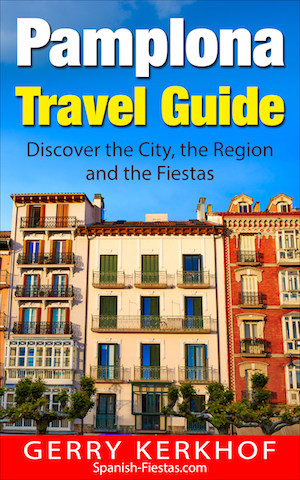
Lived in Pamplona for 6 beautiful months. This article captures the essence of the city perfectly. Small, compact, perfect. Well worth a trip! Don’t miss the outdoor swimming pool in the summer, as well as a trip to parque yamaguchi and a night out on cuesta de labrit. Aquavox an excellent public pool and spa for tired pilgrim feet. Free WiFi also throughout the city. Thanks for the guide.
Thanks for those extra tips Alice
Excellent as usual and very comprehensive.
What a great comprehensive report. I shall now add Pamploma to my list of places to visit before I die (hopefully not too soon).
Czar eat article…Brought back wonderful memories”””
Dear Gerry,
Many thanks for the information. I was unable to visit the so many interesting places when I walked past this city last time in my El Camino walk for want of information. Next time when I will be there (and I am sure I will), I will make use of your useful information and make more out of my visit.
Many thanks indeed.
Regards,
Louis
Another informative and interesting article about a city that has a lot more to offer than just the running of the bulls. Seems to have some excellent restaurants and certainly worth a visit in any season.